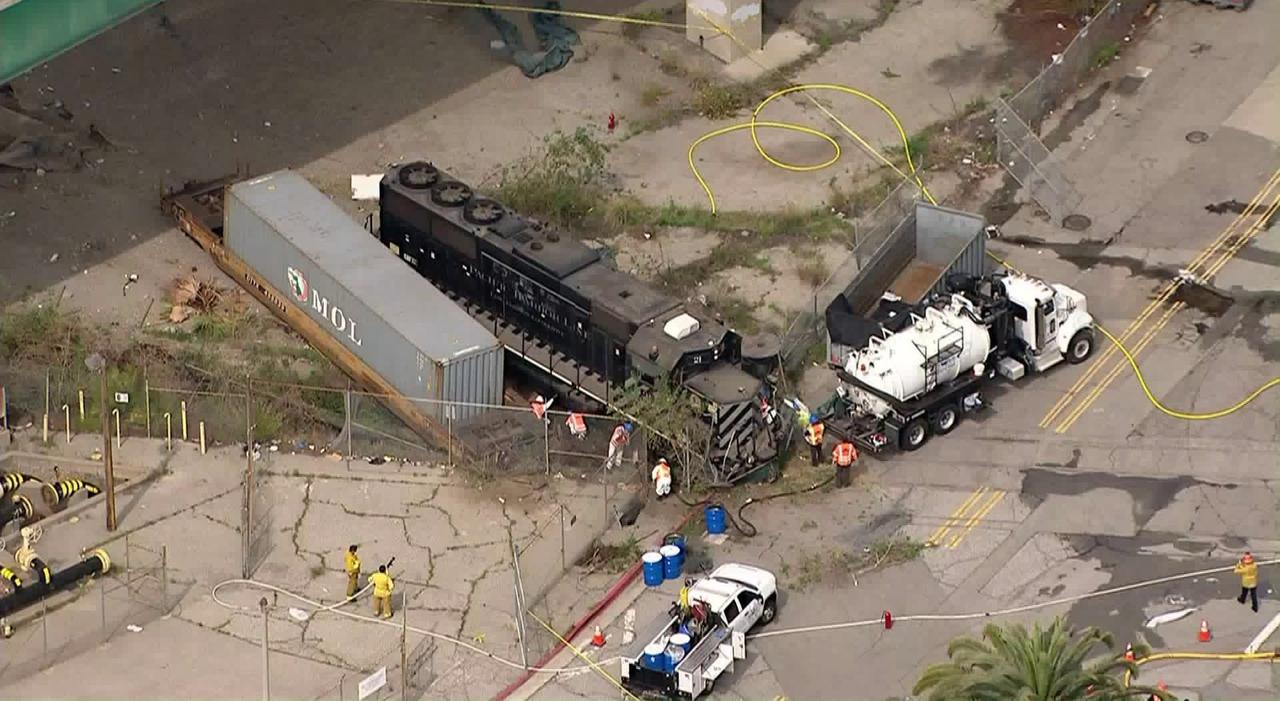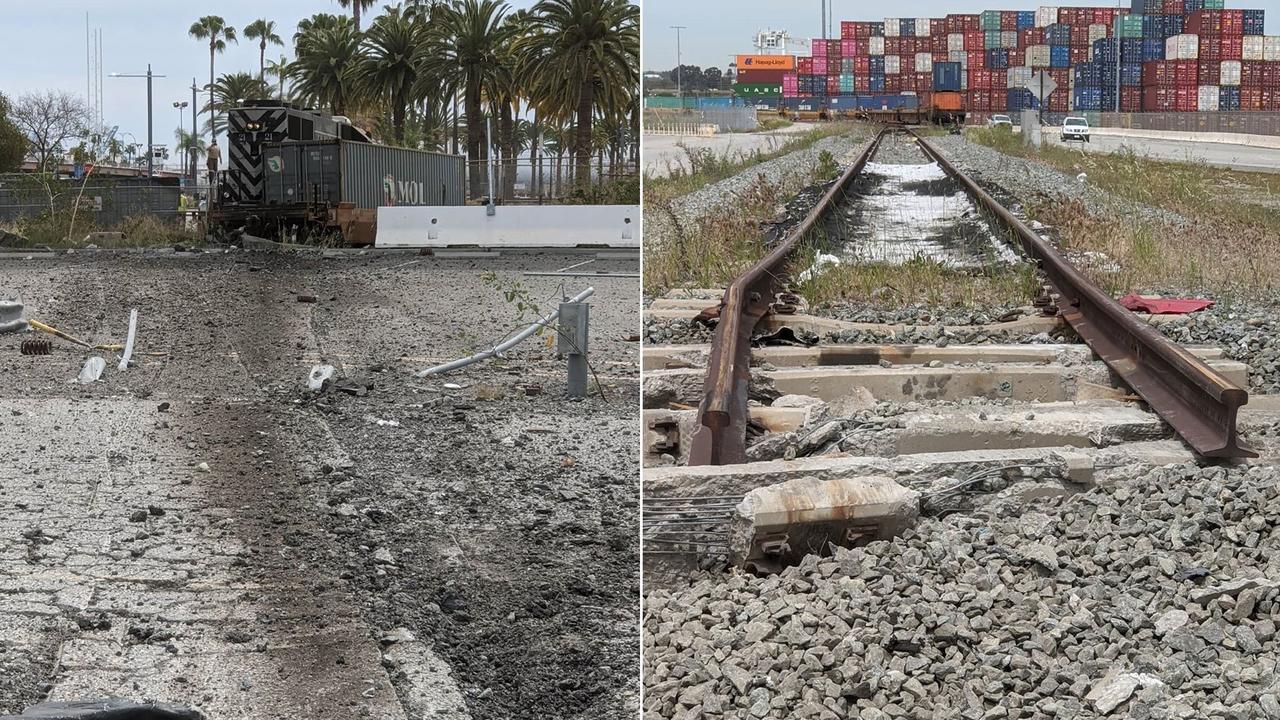“Eddie’s Not With Us At This Time”: Engineer Intentionally Wrecks Train In Attack On USNS Mercy
There are many surreal aspects to this pandemic but Eduardo Moreno is still something of a stand out. The California engineer attempted to ram his locomotive into the USNS Mercy because he was suspicious of its real purpose in Los Angeles.
His effort took the train off the rails and across a remarkable distance before stopping short of the ship. The family has started a GoFundMe page that cryptically says “Eddie is not hurt physically but isn’t with us at this time.”
The case has resulted in a relatively rare federal charge of training wrecking. By handing Moreno over to the federal prosecutors, state authorities minimized his defense options and maximized the potential sentencing.
Moreno was operating a Pacific Harbor Line train on March 31st when he decided to try to reach the ship at high speed. According to the U.S. Attorney, “Moreno ran the train off the end of tracks, and crashed through a series of barriers before coming to rest more than 250 yards from the Mercy.”
KTLA.com reports that Moreno said he wanted to “wake people up” and hoped the derailment would get media attention so “people could see for themselves,” according to prosecutors.
Firefighters responded around 12:30 p.m. Tuesday to the port, where the train came to rest about 250 yards from the Mercy after crashing through a series of barriers. No injuries were reported, but it did trigger a fuel spill that prompted a hazardous materials cleanup.
Moreno tried to flee the scene but was detained by a California Highway Patrol officer who witnessed the incident, officials said. The officer reported seeing the train smash through a concrete barrier, steel barrier and chain-link fence before sliding across a parking lot and lot filled with gravel, coming to rest against another chain-link fence.
The officer told investigators that when he spoke with Moreno, the suspect said things like, “You only get this chance once. The whole world is watching. I had to. People don’t know what’s going on here. Now they will.”
It is still not clear to me how the train could have possibly reached the ship despite traveling over an impressive distance after derailing.
That fact could be used to contest allegations of an intended collision as opposed to the current current charge of train wrecking. Nevertheless, the charge still brings a potential 20 year sentence.
We are never address a train wrecking charge before on this blog. Since we are unlikely to have another occasion soon, here is the provision:
§1992. Wrecking trains
(a) Whoever willfully derails, disables, or wrecks any train, engine, motor unit, or car used, operated, or employed in interstate or foreign commerce by any railroad; or
Whoever willfully sets fire to, or places any explosive substance on or near, or undermines any tunnel, bridge, viaduct, trestle, track, signal, station, depot, warehouse, terminal, or any other way, structure, property, or appurtenance used in the operation of any such railroad in interstate or foreign commerce, or otherwise makes any such tunnel, bridge, viaduct, trestle, track, signal, station, depot, warehouse, terminal, or any other way, structure, property, or appurtenance unworkable or unusable or hazardous to work or use, with the intent to derail, disable, or wreck a train, engine, motor unit, or car used, operated, or employed in interstate or foreign commerce; or
Whoever willfully attempts to do any of the aforesaid acts or things-
Shall be fined under this title or imprisoned not more than twenty years, or both.
(b) Whoever is convicted of a violation of subsection (a) that has resulted in the death of any person, shall be subject also to the death penalty or to imprisonment for life.
As indicated by the family’s statement, the only defense is not to contest these elements but Moreno’s mental state. It seems rather that Moreno, 44, has a questionable mental state to put it mildly. He could not explain the basis of his suspicions or why he thought a hospital ship had some nefarious purpose. Prosecutors simply recounted that Moreno confessed (after he tried to flee the scene) and said that he “was suspicious of the Mercy and believing it had an alternate purpose related to COVID-19 or a government takeover.” He also later said that he wanted to “wake people up.”
That brings us back to the federal standard for insanity. Here is the code provision at 18 U.S. Code §17:
(a)Affirmative Defense.—It is an affirmative defense to a prosecution under any Federal statute that, at the time of the commission of the acts constituting the offense, the defendant, as a result of a severe mental disease or defect, was unable to appreciate the nature and quality or the wrongfulness of his acts. Mental disease or defect does not otherwise constitute a defense.
(b)Burden of Proof.—The defendant has the burden of proving the defense of insanity by clear and convincing evidence.
After the assassination attempt of President Ronald Reagan, Congress passed the Insanity Defense Reform Act of 1984. Like many in the criminal defense field, I am a critic of the law in making it far more difficult to bring an insanity defense. Those changes are likely to impact Moreno in a particularly profound way. It put the burden on the defense to establish insanity by clear and convincing evidence while (more importantly) eliminating diminished capacity defenses.
Moreno’s effort to flee and his operation of the locomotive could present a problem for the defense. It is better suited for diminished capacity or irresistible impulse defenses which are no longer allowed. Many doctors have rightfully objected to the elimination as ignoring available science on the scope and variation of mental illness. I believe that the Alabama Supreme Court had it right in 1887 in Parsons v. State when it held that it is not enough to simply conclude that a defendant could tell right from wrong. I discussed that standard in a prior column in relation to the Andrea Yates case. Rather there is also the question whether, through “the duress of such mental disease [that] he had … lost the power to choose between right and wrong.” Thus, “his free agency was at the time destroyed” and “the alleged crime was so connected with such mental disease, in the relation of cause and effect, as to have been the product of it solely.”
Moreno strikes me as the prototypical example of a diminished capacity or an irresistible impulse defense. There is no indication that he failed to understand that his actions were wrong (including his attempted flight) or that his actions would put the ship (and areas around the ship) into danger.
The interesting element in this case is that Moreno was initially in state control but then turned over to the federal prosecutors for charges. California follows a similar type of M’Naghten (or McNaughten) rule that allows insanity as a defense when the defendant did not understand the nature of his criminal act or did not understand that it was morally wrong.
However, California may have been a better jurisdiction for Moreno due to its application not of diminished capacity but “diminished actuality” tests. Like the federal government, a single case resulted in a fundamental change in its insanity standards for criminal cases. It was not the Reagan assassination but the murder of San Francisco Supervisor Harvey Milk by Dan White. White offered the infamous “Twinkie defense” that he had a temporary chemical imbalance of the brain resulting in diminished capacity.
The public was outraged by the defense after White was convicted of voluntary manslaughter. Thus, in 1982, the voters eliminated the diminished capacity defense. Instead, a new law was passed allowing for “Diminished Actuality”. Under California Penal Code Section 28(a), the defense may present evidence that a defendant suffers from a mental disease, mental defect, or mental disorder “solely on the issue whether or not the accused actually formed a required specific intent, premeditated, deliberated, or harbored malice aforethought, when a specific intent crime is charged.”
This has resulted in a slightly more favorable standard for defendants as opposed to the federal system. Thus, by handing Moreno over to the federal prosecutors, state authorities put him into a more restrictive system with historically harsher sentencing on such crimes.
It is worth noting however that intentional train wrecking does have a pronounced interstate and federal element, particularly when the target was a federal ship. Even without the differences in state and federal laws, the federal prosecutors would have made a strong case that Moreno should be tried in federal court since he was trying to attack a U.S. military vessel responding to a national pandemic emergency.
Tyler Durden
Thu, 04/02/2020 – 11:46
via ZeroHedge News https://ift.tt/2ytDD0V Tyler Durden



